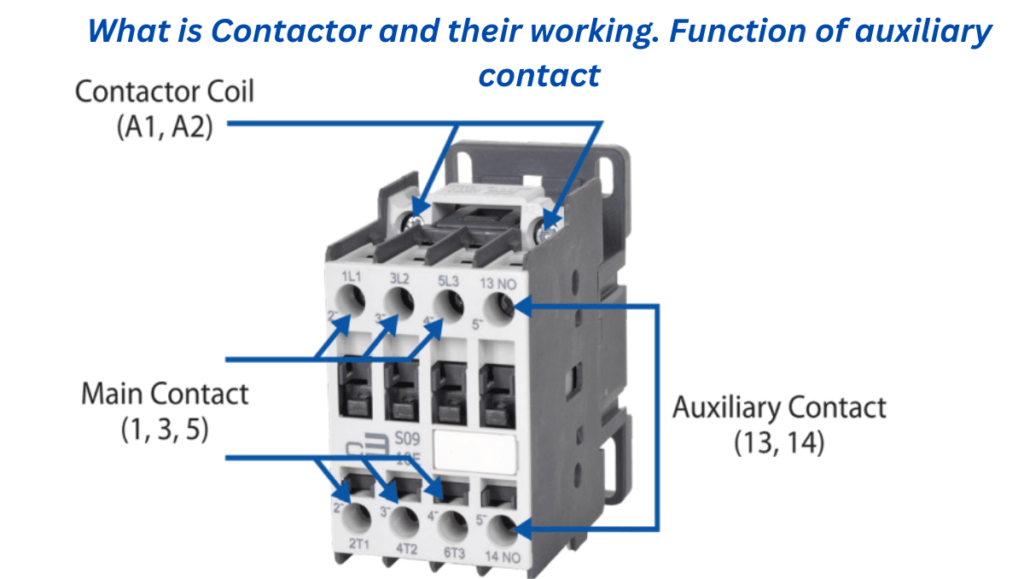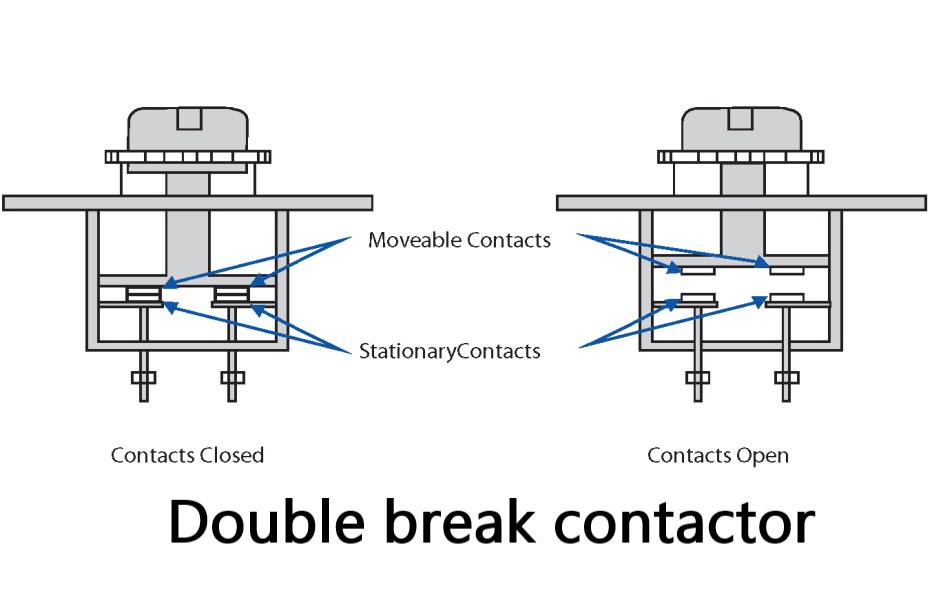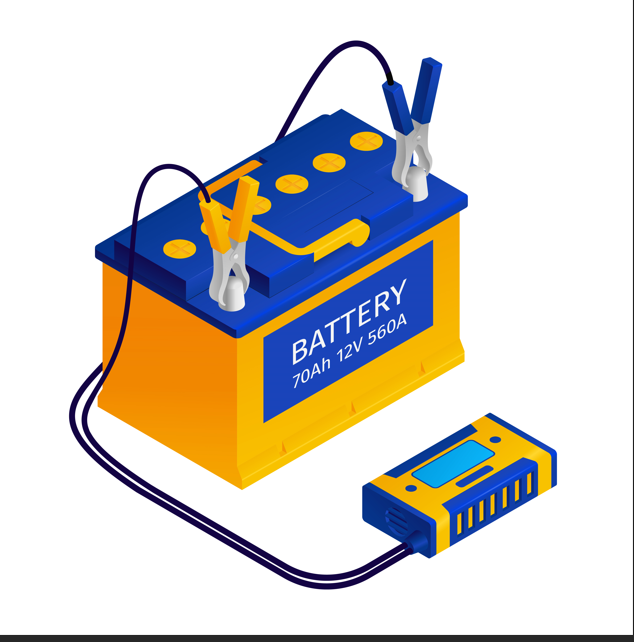
Table of Contents
ToggleDefinition
A Electrical contactor is an electrical device which is used for switching an electrical circuit on or off.A contactor is also called an “electromagnetic contactor” although it is most often merely called a “contactor”.It is considered to be a special type of relay.
However, the basic difference between the relay and contactor is that the contactor is used in applications with higher current carrying capacity, whereas the relay is used for lower current applications.
Introduction
A contactor is a relay that is used for switching power.They usually handle very heavy loads like an electric motor, lighting and heating equipment and so on.
Though their output is used for switching very high loads, they are controlled by a circuit with very less power. According to the loads they handle, they vary in sizes from a small device to as huge as a yard.
There are various types of contactors, and each type has its own set of features, capabilities, and applications. Contactors can break current over a wide range of currents, from a few amperes to thousands of amperes, and voltages from 24 VDC to thousands of volts.
The most common application area of the contactor is high-current load. Contactors are known for their capability to handle currents of over 5000 amperes and high power over 100 kW. Heavy motor currents produce arcs when being interrupted. These arcs can be reduced and controlled using a contactor.
Contactors are available in two pole, three pole and four pole configurations. Both enclosed and open designs are common. The open design is intended for mounting in a customer’s enclosure. Most contactors are normally open although normally closed contactors are also available for specialized applications.
Working principle of Contactor

A contactor also has
- Contact
- Spring
- Electromagnet
The current passing through the contactor excites the electromagnet. The excited electromagnet produces a magnetic field, causing the contactor core to move the armature.
A normally closed (NC) contact completes the circuit between the fixed contacts and the moving contacts.
This permits the current to pass through these contacts to the load. When current is removed, the coil is de-energized and opens the circuit. The contacts of the contactors are known for their rapid open and close action.
The contacts are controlled by the electromagnet. These electromagnets give the initial force to the contacts and make them closed. Both these contacts and electromagnet are enclosed in a frame which is usually made of insulating materials.
The usually used insulating materials are Nylon 6, thermosetting plastics and so on. They are useful, as they completely insulate the contacts and help in preventing the touch of contacts.
For high-end contactors, an open-frame contactor is commonly used. This will provide a greater protection from oil, dust, weather and also from explosion.
Components of the contactor
- Coil or Electromagnet: This is the most crucial component of a contactor. The driving force that is required to close the contacts is provided by the coil or electromagnet of the contactor. The coil or electromagnet and contacts are protected by an enclosure.
- Enclosure: Just like the enclosures used in any other application, contactors also feature an enclosure, which provides insulation and protection from personnel touching the contacts. The protective enclosure is made from different materials, such as polycarbonate, polyester, Nylon 6, Bakelite, thermosetting plastics, and others. Generally, the open-frame contactor features an additional enclosure, which protects the device from bad weather, hazards of explosion, dust, and oil.
- Contacts: This is yet another important component of this electrical device. The current carrying task of the contactor is done by the contacts. There are different types of contacts in a contactor namely, contact springs, auxiliary contacts, and power contacts. Each type of contact has an individual role to play.
Purpose of Auxiliary contact and power contact
Auxiliary contact:
Auxiliary contacts, which would have a lower current rating than the main contacts, are available with most contactors. The auxiliary contacts are often used for the purpose of interlocking in control circuits or for the purpose of remote indication of contactor position.
Power contact:
Power contact have capacity to pass electric current as per their setting.The power contacts gains the power for the contactor.
Types of Contactor
Different types of contactor use as per their working.
Knife Blade Switch
It was probably the first ever contactor that was used to control (start or stop) electric motors. The switch consisted of a metal strip, which would drop onto a contact. This switch had a lever for pulling the switch down or pushing it up. Back then, one had to level the knife blade switch into the closed position by standing next to it.
However, there was a problem with this method of switching. This method caused the contacts to wear out quickly, since it was difficult to manually open and close the switch fast enough to avoid arcing. As a result of this, the soft copper switches underwent corrosion, which further made them vulnerable to moisture and dirt.
Manual Controller(Double break contactor)

Since the knife blade switch became potentially dangerous to use, engineers came up with another contactor device, which offered a number of features that were missing in the knife blade switch. This device was referred to as a manual controller. These features included:
Safe to operate
Non-exposed unit, which is properly encased
Physically smaller size
Single break contacts replaced with double break contact
As their name implies, double break contacts can open the circuit in two places at the same time. Thus, even in smaller space, it allows you to work with more current. Double break contacts divide the connection in such a way that it forms two sets of contacts.
The switch or button of the manual controller is not operated remotely and is attached to the controller physically.
The power circuit is engaged once the manual controller is activated by an operator. Once activated, it carries the electricity to the load. Soon, manual contactors replaced knife blade switches completely, and even today different variations of these types of contactors are being used.
Magnetic Contactor
The magnetic contactor does not require human intervention and operates electromechanically. This is one of the most advanced designs of a contactor, which can be operated remotely. Thus, it helps eliminate the risks involved in operating it manually and putting operating personnel in potential danger.
Only a small amount of control current is required by the magnetic contactor to open or close the circuit. This is the most common type of contactor used in industrial control applications.
Contactor Ratings
Ratings of a contactor are given according to the pole of the contactor. It also depends on factors like fault withstand current, coil voltage and so on. According to their rating, contactors are classified into the following.
AC1 – Non-inductive rows
AC2 – Contactors for starting of slip-ring motors
AC3 – Starting of squirrel-cage motors and switching off only after the motor is up to speed.
AC4 – Starting of squirrel-cage motors with inching and plugging duty.
AC11 – Auxiliary control circuits
Application of Contactor
Lighting Control Contactors are often used to provide central control of large lighting installations, such as an office building or retail building. To reduce power consumption in the contactor coils, latching contactors are used, which have two operating coils. One coil, momentarily energized, closes the power circuit contacts, which are then mechanically held closed; the second coil opens the contacts.
Electric Motor Starter Contactors can be used as a magnetic starter. A magnetic starter is a device designed to provide power to electric motors. It includes a contactor as an essential component, while also providing power-cutoff, under-voltage, and overload protection.
Contactor use with MCB(Miniature Circuit Breaker) to protect electrica circuit several field.
Frequently Asked Question (FAQ)
What is contactor?
A Electrical contactor is an electrical device which is used for switching an electrical circuit on or off.A contactor is also called an “electromagnetic contactor” although it is most often merely called a “contactor”.It is considered to be a special type of relay.
What is component of contactor?
Coil or electromagnet, Contact and enclosure
What is defference between contactor and relay?
The basic difference between the relay and contactor is that the contactor is used in applications with higher current carrying capacity, whereas the relay is used for lower current applications.
Why Contactor use in industrial application?
Contactor is special type relay,which is used switch current to an electric motor. Large motor can protect from overload by using overload contactor.
What is difference between AC and DC contactor?
Main difference is their arc extinguishing devices. AC contactor use grid arc extinguishing device while DC contacto adopts magnetic quenching arc extinguishing.
What is ampere and voltage rating of contactor?
Rating of Contactor is use as per application. Ampere and Voltage range of contactor is thousands times but applicability as per requirement.



私共のサービスは表題の通り、お客様に代わってAI営業マンが
企業・個人事業主様に対して営業をおこないます。
営業先は最大で450万件(日本全国)
1件あたりのコストは0.075円(100万件の場合)と破格でございます。
強みは価格だけではなく【企業・個人事業主様に直接営業できること】
しかも【リストが新鮮】で新旧リストが追加・削除を毎日更新されています。
お試しプランもございますので是非ご利用くださいませ。
反応率(お問い合わせ率)高いサービスであることは間違いはないので
よければWEBサイトをご覧下さい。
https://pc65q.hp.peraichi.com/contact2
━━━━━━━━━━━━━━━━━━━━━━━━━━━━━━━━━━━━━
*発信者名:湊システム配信サービス
━━━━━━━━━━━━━━━━━━━━━━━━━━━━━━━━━━━━━
代表者様
問合せフォームからの突然のご連絡失礼します。
御社や店舗を【Google口コミ高評価のみ】を集める新しい施策が出来ましたのでご連絡させて頂きました。
Google上位表示へあげ、集客に非常に必要な高評価口コミを増やし集客にご協力できればと思います。
またGoogleにてビックワード含め【上位3枠】表示させ集客、売上UPさせる施策もあります。
特徴は以下4点です。
ーーーーーー
・Googleレビュー高評価4,5のみ集める事が出来る
・レビュー分析、口コミ自動返信も可能
・インサイト分析でどれくらい来店が増えたかの分析も可能
・検索表示されるので売り上げ認知UP“”売上300%“”実績あり
・初期費用無料の為導入ハードルが低い
ーーーーーー
貴社のような類似サービスを扱う企業様での活用事例をまじえて
ZOOMにて説明のお時間をいただけると幸いです。
またメールの場合はyatabe@leadon.co.jpへご連絡頂いても打合せ日程候補お送りさせて頂きますので
ご多忙の中恐れ入りますが、ご連絡お待ちしております。
何卒宜しくお願い致します。
〜〜〜〜〜〜〜〜〜〜〜〜〜〜〜〜〜〜〜
株式会社Leadon代表取締役社長
谷田部隆士 / YATABE RYUJI
〒107-0062 東京都港区2-2-15
TEL: 03-6555-2546
Email: yatabe@leadon.co.jp
URL: https://www.leadon.co.jp/
〜〜〜〜〜〜〜〜〜〜〜〜〜〜〜〜〜〜〜
Pingback: DC distribution in 132 KV, 220 KV, 400 KV Control and Relay Panel in substation
Hey! I couhld have sworn I’vebeen too this site before
butt after checking through some of the post I realized it’s new
to me. Anyways, I’m definitely glad I found it and I’ll bbe
bookmarking and checking back often! https://www.Waste-ndc.pro/community/profile/tressa79906983/
Yes! Finally something about sonablate. https://menbehealth.wordpress.com/
It’s the best time to make some plans for the future and it’s time to be
happy. I have read this post and if I could I want to suggest you
some interesting things or advice. Maybe you could write next articles referring to this article.
I desire to read even more things about it! https://www.thesun.ie/tvandshowbiz/14658731/towie-jake-hall-kanye-west-bianca-censori-party-grammys/
It’s the best time to make some plans for the future
and it’s time to be happy. I have read this post and if I could
I want to suggest you some interesting things or advice.
Maybe you could write next articles referring to this article.
I desire to read even more things about it! https://www.thesun.ie/tvandshowbiz/14658731/towie-jake-hall-kanye-west-bianca-censori-party-grammys/
Hello very nice site!! Man .. Excellent ..
Amazing .. I’ll bookmark your web site and take the feeds additionally?
I’m satisfied to find so many useful info here within the put up,
we need develop extra techniques on this regard, thanks for sharing.
. . . . . https://www.syracuse.com/betting/2024/11/los-angeles-lakers-vs-orlando-magic-prediction-our-nba-preview-for-tonights-game-112124.html https://www.syracuse.com/betting/2024/11/los-angeles-lakers-vs-orlando-magic-prediction-our-nba-preview-for-tonights-game-112124.html
Hello very nice site!! Man .. Excellent .. Amazing ..
I’ll bookmark your web site and take the feeds additionally?
I’m satisfied to find so many useful info here within the put up, we need develop extra techniques on this regard,
thanks for sharing. . . . . . https://www.syracuse.com/betting/2024/11/los-angeles-lakers-vs-orlando-magic-prediction-our-nba-preview-for-tonights-game-112124.html https://www.syracuse.com/betting/2024/11/los-angeles-lakers-vs-orlando-magic-prediction-our-nba-preview-for-tonights-game-112124.html
Thanks a Lot!
share my post to your friends to appreciate my work.
And keep learning
Hi, after reading this remarkable post i am as well cheerful
to share my experience here with colleagues. http://warm-platypus-z2f431.mystrikingly.com
Thanks a Lot!
share my post to your friends to appreciate my work.
When I originally commented I clicked the “Notify me when new comments are added” checkbox
and now each time a comment is added I get three emails with
the same comment. Is there any way you can remove people from that
service? Many thanks!
Also visit my blog; nordvpn coupons inspiresensation
What i do not understood is in reality how you are not actually much more neatly-appreciated than you may
be right now. You’re so intelligent. You recognize thus considerably when it comes to this topic, made me for
my part imagine it from a lot of varied angles. Its like men aand women are not involved unless it is one thing to accomplish with Lady gaga!
Your individual stuffs excellent. Always handle it up!
hi,
thanks for appreciation. Now, my focus on spread my website content to more readers.
To boost my moral, Please share my website to your friends and subscribe my Insta/Telegram/Whatsapp group.
What’s up to every , for the reason that I am genuinely keen of
reading this web site’s post to be updated daily.
It consists of pleasant data.
Thanks for appreciation.
For more electrical Knowledge, Please follow my Insta/Telegram/Whatsapp group.
Now, my focus on spread my website content to more readers.
To boost my moral, Please share my website to your friends.
Hurrah, that’swhat I was searching for, what a stuff! present here at
this weblog, thanks admin of this web site.
Thanks for appreciation.
For more electrical Knowledge, Please follow my Insta/Telegram/Whatsapp group.
Now, my focus on spread my website content to more readers.
To boost my moral, Please share my website to your friends.
I visited many web sites except the audio feature for
audio songs existing at this site is really superb.
Thanks a lot!
Please share my website to your friends group.
For more updates please Follow my Telegram/Whatsapp/Insta group